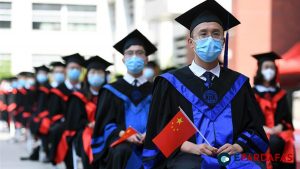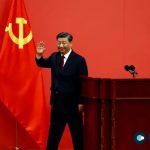
China’s Economic Reality Clashes with Beijing’s Rosy Rhetoric: GDP Slowdown Foreseen by Economists
New economic forecasts for China show Beijing’s efforts to promote an optimistic narrative have not shaken predictions of a long-term slowdown, with the growth rate seen sinking well below 5%.
A survey of 31 economists, jointly conducted by Nikkei and Nikkei Quick News in March, revealed an average projection of 4.7% growth in 2024. This is marginally up from the 4.6% rate they forecast in a December survey but lower than Beijing’s official target of “around 5%” announced at the National People’s Congress in early March. Twenty-seven of the economists predicted growth below 5%, mainly pointing to the sluggish housing market and a lack of sufficient policies to stimulate demand.
The experts from major banks and institutions see the downturn deepening in the years ahead, predicting 4.4% for 2025 and 4.2% for 2026, amid the ongoing property crisis, weak consumption and challenges posed by an aging population.
The figures show economists are not buying into Beijing’s push to “sing the bright prospects of China’s economy,” which in December became an official objective at the Central Economic Work Conference of the Chinese Communist Party. In the policy-setting meeting hosted by President Xi Jinping, a call was made to “enhance economic propaganda and to guide the public,” as state news agency Xinhua reported.
Xi reiterated this point when he met American business leaders and top scholars in Beijing on March 27. “The prospect of China’s development is bright, and we have the vigor and the confidence,” Xinhua quoted him as saying.
The average forecast for the January-March quarter’s gross domestic product growth was 4.5%, on a year-on-year basis. Industrial production in January and February increased by 7% on the year, inching up from 6.8% in December. Thanks to improved production-related indicators, the seasonally adjusted quarter-on-quarter growth rate was 1.2%, slightly up from 1% for October-December 2023.
Wei Yao, chief Asia and China economist at Societe Generale, raised her forecast for the year to 4.7% from 4.5%. “This year’s recovery will be supported by better exports given the lower chance of an imminent recession in the U.S. and faster infrastructure capex momentum on the back of more funding support.”
But Lynn Song, ING Economics’ chief economist for greater China, stressed, “While consumption carried the lion’s share of growth in 2023, weak consumer confidence and a negative wealth effect may limit how much consumption can contribute this year.” He added that supportive policies will be needed to reach the 5% growth target.
Most agree that the real estate slump poses the most significant challenge this year, given that China’s property sector accounts for 50% to 60% of household assets. The deteriorating market conditions have a profound impact on consumer confidence.
“We expect persistent weakness in the real estate sector to constrain economic growth in [the first half of this year],” Fitch Ratings analysts including chief economist Brian Coulton wrote in a report. Coulton’s earlier report predicted that housing sales would further decline by 5% to 10% this year.
Tetsuji Sano, Sumitomo Mitsui DS Asset Management’s chief Asia economist, warned of a “vicious cycle of deflation” in which downward pressure on wages intensifies as corporate performance worsens, reducing purchasing power.
Nominal GDP was lower than real GDP in 2023, indicating deflationary pressure already taking hold. “I would not be surprised if this trend continues in 2024,” he added.
Residential buildings in Beijing on March 11. The slumping property market continues to weigh on the economy. (Photo by Mizuho Miyazaki)
Many expressed concern about the limitations of fiscal policy measures. While the government in March signaled it was ready to lend support, including a 1 trillion yuan ($139.3 billion) special bond program in 2024, economists said it would take more to boost consumer confidence.
Bert Burger, principal economist at Atradius, suggested raising pensions and unemployment benefits to reduce the need for precautionary savings and spur domestic demand. “The Chinese government still focuses on manufacturing production instead of consumption,” Burger said. “It relies on exports to countries that are not always willing to accept Chinese products.”
Larry Hu, head of China economics at Macquarie, echoed Burger’s view. “Even worse, the robust manufacturing and infrastructure spending have bolstered activity indicators, thereby reducing the urgency felt by policymakers for stimulus,” he stressed.
As for monetary policy, the economists expect the one-year loan prime rate (LPR), the de facto policy rate, will drop to 3.27% by the end of 2024, lower than the current 3.45%.
While DBS economist Samuel Tse said the “reduction in borrowing costs is expected to bolster investment sentiment moving forward,” the U.S. Federal Reserve may not be in a rush to cut rates, which could affect the pace of rate cuts in China.
“The fact that the U.S. economy is growing at such a solid pace, the fact that the labor market is still very, very strong, gives us the chance to just be a little more confident about inflation coming down before we take the important step of cutting rates,” Fed Chairman Jerome Powell said Friday in San Francisco.
When asked a multiple-choice question about this year’s economic risk factors, economists chose the real estate woes and a lack of sufficient policies as the most significant, though the U.S. presidential election in November loomed large as well.
“Policymakers would be hesitant to go much further given their desire to hold the line on de-risking the economy,” said Robert Gilhooly, senior emerging markets economist of global macro research at ABRDN. Gilhooly explained that Beijing needs to “keep some policy powder dry” to address “the potential shock” in trade tensions with the U.S. under a Trump presidency.
“The U.S. presidential election directly impacts trade policies and technological restrictions, which have both short-term effects on overall demand and long-term implications for economic growth potential,” said Ken Chen, Chinese economy analyst at KGI.
On the currency front, views were mixed. The yuan — also known as the renminbi — is expected to land between 6.9 to 7.4 per dollar at the end of the year, with an average forecast of 7.08. This would be slightly weaker than 7.0 in the previous December survey, but a bit stronger than the 7.0957 yuan per dollar rate set by the Chinese central bank on Tuesday.
“The renminbi will remain weak as bearish views on the Chinese economy are growing due to the real estate issue,” said Katrina Ell, senior economist at Moody’s Analytics. “If the interest rate differential with overseas countries such as the United States narrows … the pressure on the yuan to depreciate will be eased.”
China’s aging population is dragging down the growth of the world’s No. 2 economy. Lombard Odier’s senior macro strategist, Homing Lee, expects the rate to be 3.9% in 2026, below the 4% mark. “Ultimately, 5% growth is simply not advisable for an economy that will experience significant demographic aging and economic maturation,” he added.
The economists who responded to the survey:
Arjen van Dijkhuizen, senior economist, ABN AMRO Bank; Robert Gilhooly, senior emerging markets economist, global macro research, Abrdn; Francoise Huang, senior economist for Asia-Pacific, Allianz Trade; Bert Burger, principal economist, Atradius; Jian Chang, director and chief China economist, Barclays Asia Pacific; Ricky Choi and Francis Cheng, chief economist and economist, Bank of East Asia; Helen Qiao, head of Asia economics, BofA Global Research; Yue Tan, equity research associate, Daiwa Capital Market; Samuel Tse, economist, DBS; Kenny Ng, securities strategist, Everbright Securities International; Brian Coulton, chief economist, Fitch Ratings; Hui Shan, chief China economist, Goldman; Thomas Shik, chief economist, Hang Seng Bank; Jing Liu, chief economist for greater China, HSBC; Lynn Song, chief economist for greater China, ING Economics; Sophie Altermatt, economist, Julius Baer; Ken Chen, Chinese economy analyst, KGI ASIA; Matthew Roger, economist, Legal & General Investment; Homin Lee, senior macro strategist, Lombard Odier; Larry Hu, chief China economist, Macquarie; Robin Xing, cheif China economist, Morgan Stanley; Ito Hideki, senior economist, Mizuho Bank (China); Katrina Ell, director of economic research, Moody’s Analytics; Fan Xiaochen, director of economic research office (Hong Kong), MUFG Bank; Gary Ng, senior economist, Natixis; Ting Lu, chief China economist, Nomura; Louis Kuijs, Asia-Pacific chief economist, S&P Global Ratings; Wei Yao and Michelle Lam, chief Asia and China economist and greater China economist, Societe Generale; Shuang Ding, chief economist, greater China, and North Asia, Standard Chartered Bank (HK); Sano, chief Asia economist, Sumitomo Mitsui DS Asset Management (Hong Kong); Wang Tao, head of Asia economics and chief China economist, UBS.













Comments